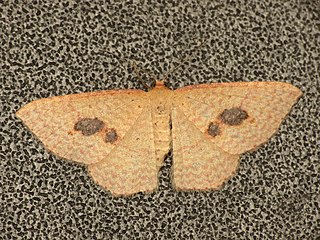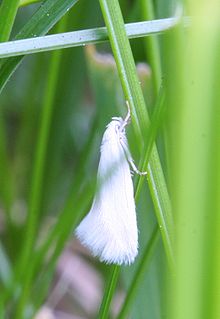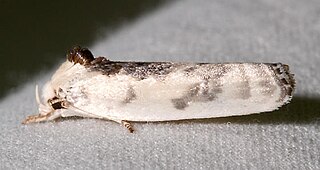
Spilomelinae is a very large subfamily of the lepidopteran family Crambidae, the crambid snout moths. They were formerly included in the Pyraustinae as tribe Spilomelini; furthermore taxonomists' opinions differ as to the correct placement of the Crambidae, some authorities treating them as a subfamily (Crambinae) of the family Pyralidae. If this is done, Spilomelinae is usually treated as a separate subfamily within Pyralidae. The Spilomelinae are believed to be polyphyletic. Many genera are only tentatively placed here even at this point.
Urodidae or "false burnet moths" is a family of insects in the lepidopteran order, representing its own superfamily, Urodoidea, with three genera, one of which, Wockia, occurs in Europe.

Dichomeris is a genus of moths, in the family Gelechiidae, described by Jacob Hübner in 1818.
Telphusa is a genus of moth in the family Gelechiidae.
Bradina is a genus of moths of the family Crambidae.
Tatobotys is a genus of moths of the family Crambidae described by Arthur Gardiner Butler in 1881.

Epicyme is a monotypic moth genus in the family Geometridae described by Meyrick in 1885. Its only species, Epicyme rubropunctaria, the red-spotted delicate, described by Doubleday in 1843, is found in New Zealand, the Australian Capital Territory, Tasmania and Victoria.

Macrobathra is a genus of moth in the family Cosmopterigidae. Most species are endemic to Australia.

Platyptilia is a genus of moths in the family Pterophoridae. The genus was described by Jacob Hübner in 1825.

Elachista is a genus of gelechioid moths described by Georg Friedrich Treitschke in 1833. It is the type genus of the grass-miner moth family (Elachistidae). This family is sometimes circumscribed very loosely, including for example the Agonoxenidae and Ethmiidae which seem to be quite distinct among the Gelechioidea, as well as other lineages which are widely held to be closer to Oecophora than to Elachista and are thus placed in the concealer moth family Oecophoridae here.
Macropiratidae is a family of moths which has sometimes been treated as a subfamily of the Pterophoridae, owing to the resemblance between specimens of Macropiratidae and plume moths of the genus Agdistis, at least when preserved as pinned specimens. The family contains a single genus Agdistopis with three species.

Antaeotricha is a genus of moth. It is the largest genus in the subfamily Stenomatinae, numbering over 400 species in the Western Hemisphere.

Acrocercops is a genus of moths in the family Gracillariidae.

Crocydopora is a monotypic snout moth genus described by Edward Meyrick in 1882. Its single species, Crocydopora cinigerella, described by Francis Walker in 1866 is known from Australia and New Zealand.
Cerconota is a genus of moths in the family Depressariidae. In 1991, I. W. B. Nye and David Stephen Fletcher included it in the family Oecophoridae and the subfamily Stenomatinae. It was later placed in the family Elachistidae and subfamily Stenomatinae by Ronald W. Hodges, in Niels Peder Kristensen (1999). Other classifications placed them in the Elachistidae or Oecophoridae, but they actually seem to belong to the Depressariidae.
Musotiminae is a subfamily of the lepidopteran family Crambidae. It was described by Edward Meyrick in 1884

Epermenia is a genus of moths in the family Epermeniidae. The genus was first described by Jacob Hübner in 1825.

Gelechiinae is a subfamily of moths in the family Gelechiidae. It was described by Henry Tibbats Stainton in 1854.

The Stenomatinae are a subfamily of small moths in the family Depressariidae.

Stenoma is a genus of moths. The type species is Stenoma litura, which was described by Philipp Christoph Zeller in 1839.














